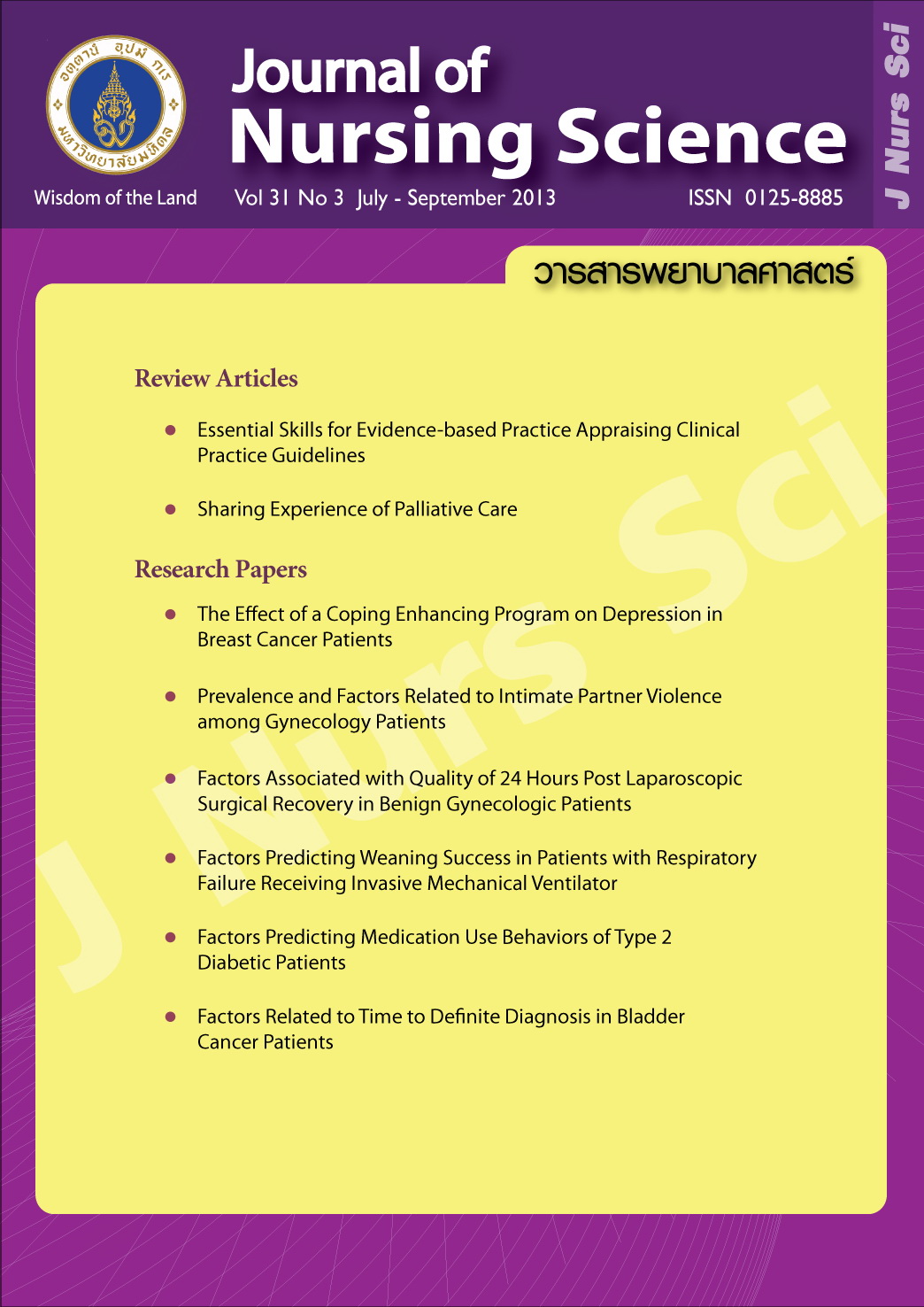Factors Related to Time to Definite Diagnosis in Bladder Cancer Patients
Main Article Content
Abstract
Purpose: The present study was aimed at investigating the relationships between perceived severity of bladder cancer, knowledge of bladder cancer, fear caused by abnormal symptoms of bladder cancer, social support and time to definite diagnosis in bladder cancer patients.
Design: A descriptive correlational study design.
Methods: The sample consisted of 90 bladder cancer patients at every stage of the disease, both males and females, who sought treatment at the urology outpatient and inpatient departments of a hospital. Data were collected using the demographic characteristics interview, illness data, time to definite diagnosis, perceived severity of bladder cancer, knowledge of bladder cancer, fear of abnormal symptoms of bladder cancer, and social support. The data were analyzed using descriptive statistics and Spearman’s rank correlation.
Main findings: Time to definite diagnosis with urologists ranged from one day to 1,460 days, with the mean of 183.72 days (SD = 281.99 ), and the median of 60 days. Perceived severity of bladder cancer was associated with time to definite diagnosis in bladder cancer patients with statistical significance (rs = - .49, p < .01). Finally, knowledge of bladder cancer patients was negatively related to time to definite diagnosis with statistical significance (rs = - .42, p < .01), but fear of abnormal symptoms of bladder cancer and social support were not related to time to definite diagnosis.
Conclusion and recommendations: Based on the study findings, it is recommended that nurses and healthcare personnel should widely disseminate knowledge and advice on bladder cancer and its severity to encourage shorter time to definite diagnosis and treatment.
ปัจจัยที่มีความสัมพันธ์กับระยะเวลาการมารับการรักษาในผู้ป่วยมะเร็งกระเพาะปัสสาวะ
ประนอม พรมแดง, สุพร ดนัยดุษฎีกุล, อรพรรณ โตสิงห์, ภควัฒน์ ระมาตร์
บทคัดย่อ
วัตถุประสงค์: ศึกษาความสัมพันธ์ระหว่างการรับรู้ความรุนแรงของโรคมะเร็งกระเพาะปัสสาวะ ความรู้เรื่องโรคมะเร็งกระเพาะปัสสาวะ ความกลัวเมื่อเกิดอาการผิดปกติของโรคมะเร็งกระเพาะปัสสาวะ การสนับสนุนทางสังคม กับระยะเวลาการมารับการรักษาในผู้ป่วยมะเร็งกระเพาะปัสสาวะ
รูปแบบการวิจัย: การวิจัยครั้งนี้เป็นการศึกษาความสัมพันธ์เชิงพรรณนา
วิธีดำเนินการวิจัย: กลุ่มตัวอย่างเป็นผู้ป่วยมะเร็งกระเพาะปัสสาวะเพศชายและเพศหญิงที่มารับการตรวจและรักษาในโรงพยาบาลแห่งหนึ่ง จำนวน 90 ราย เก็บข้อมูลโดยใช้แบบสัมภาษณ์ ข้อมูลส่วนบุคคล ข้อมูลการเจ็บป่วย ระยะเวลาการมารับการรักษา การรับรู้ความรุนแรงของโรคมะเร็งกระเพาะปัสสาวะ ความรู้เรื่องโรคมะเร็งกระเพาะปัสสาวะ ความกลัวเมื่อเกิดอาการผิดปกติของโรคมะเร็งกระเพาะปัสสาวะ และการสนับสนุนทางสังคม วิเคราะห์ข้อมูลด้วยสถิติพรรณนาและสถิติวิเคราะห์ความสัมพันธ์สเปียร์แมน
ผลการวิจัย: ระยะเวลาการมารับการรักษา ตั้งแต่เริ่มเกิดอาการผิดปกติครั้งแรกจนมารับการรักษากับแพทย์ศัลยศาสตร์ยูโร ระยะเวลาต่ำสุด 1 วัน สูงสุด 1,460 วัน ค่าเฉลี่ย 183.72 วัน (SD = 281.99) ค่ามัธยฐาน 60 วัน การรับรู้ความรุนแรงของโรคมะเร็งกระเพาะปัสสาวะมีความสัมพันธ์ทางลบ กับระยะเวลาการมารับการรักษาในผู้ป่วยมะเร็งกระเพาะปัสสาวะอย่างมีนัยสำคัญทางสถิติ (rs = - .49, p < .01) ความรู้เรื่องโรคของผู้ป่วยมะเร็งกระเพาะปัสสาวะมีความสัมพันธ์ทางลบกับระยะเวลาการมารับการรักษาในผู้ป่วยมะเร็งกระเพาะปัสสาวะอย่างมีนัยสำคัญทางสถิติ (rs = - .42, p < .01) แต่ความกลัวเมื่อเกิดอาการผิดปกติของโรค และการสนับสนุนทางสังคมไม่มีความสัมพันธ์กับระยะเวลาการมารับการรักษาในผู้ป่วยมะเร็งกระเพาะปัสสาวะ
ข้อสรุปและข้อเสนอแนะ: พยาบาลและบุคลากรทางสุขภาพควรมีการเผยแพร่ให้คำแนะนำ ความรุนแรงของโรค และความรู้เรื่องโรคมะเร็งกระเพาะปัสสาวะให้เป็นที่แพร่หลาย เพื่อให้ประชาชนมารับการตรวจวินิจฉัยและรักษาในระยะเวลาที่เร็วขึ้น
คำสำคัญ: มะเร็งกระเพาะปัสสาวะ การรับรู้ความรุนแรงของโรค การสนับสนุนทางสังคม ระยะเวลาการมารับการรักษา
Article Details
Copyright Notice: Nursing Science Journal of Thailand has exclusive rights to publish and distribute the manuscript and all contents therein. Without the journal’s permission, the dissemination of the manuscript in another journal or online, and the reproduction of the manuscript for non-educational purpose are prohibited.

Disclaimer: The opinion expressed and figures provided in this journal, NSJT, are the sole responsibility of the authors. The editorial board bears no responsibility in this regard.


